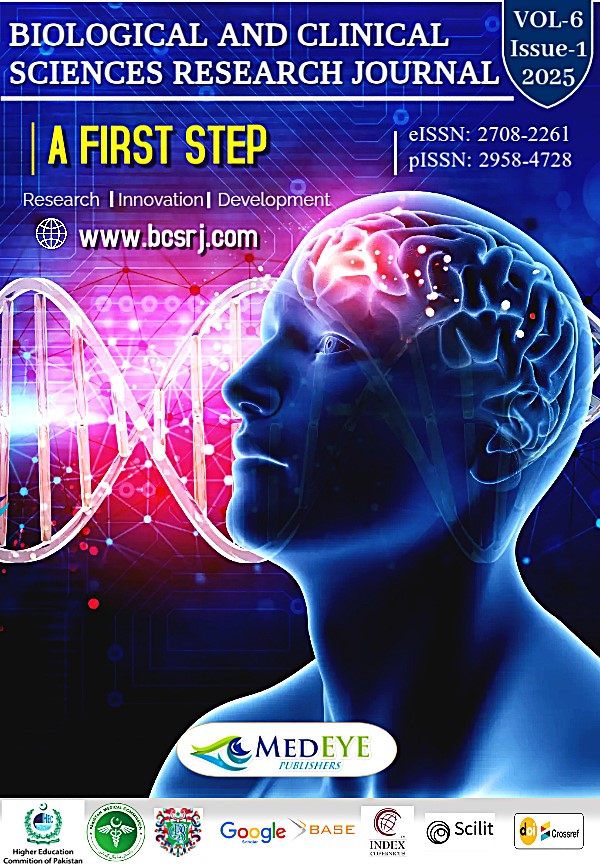Frequency of Factors Leading To Intrapartum Perineal Tears in Primigravida
DOI:
https://doi.org/10.54112/bcsrj.v6i1.1510Keywords:
Intrapartum Perineal Tears, Primigravida, Episiotomy, Vacuum Delivery, Macrosomia, PakistanAbstract
Intrapartum perineal tears are common complications during childbirth, particularly in primigravida women. Several factors, including episiotomy, vacuum-assisted delivery, and fetal macrosomia, influence the occurrence of these tears. This study aimed to evaluate the frequency and associated factors leading to intrapartum perineal tears in primigravida women in a hospital setting in Peshawar, Pakistan. Objective: To evaluate the frequency and associated factors leading to intrapartum perineal tears in primigravida women in a hospital setting in Peshawar, Pakistan Methods: This cross-sectional study was conducted at the Department of Obstetrics and Gynaecology, Hayatabad Medical Complex, Peshawar, from 15th January 2021 to 15th July 2021. A total of 123 primigravida women with singleton pregnancies were included in the study. The sample size was calculated using the WHO sample size calculator with a 95% confidence interval and a 7% margin of error. Participants were selected using non-probability consecutive sampling. Demographic data and information on episiotomy, vacuum delivery, and macrosomia were collected through a structured proforma. Data were analyzed using SPSS version 22, and descriptive statistics and chi-square tests were used to identify associations. Results: The mean age of participants was 27.1 ± 2.45 years, with a mean gestational age of 38.6 ± 1.28 weeks and a mean weight of 68.5 ± 5.97 kg. Episiotomy was performed in 21.1% of cases, vacuum delivery in 29.3%, and macrosomia was observed in 32.5% of the participants. Stratification of episiotomy, vacuum delivery, and macrosomia by age, gestational age, and weight revealed no significant associations (p-value >0.05). The episiotomy rate was higher in women weighing ≤70 kg (24.7%) and those aged 18–30 years (23.7%). Vacuum delivery was more common in younger women (29.7%) and in those weighing >70 kg (36.7%). Conclusion: Episiotomy, vacuum delivery, and macrosomia were identified as key factors associated with intrapartum perineal tears in primigravida women. The findings suggest that variations in obstetric practices, maternal weight, and fetal characteristics play a significant role in the incidence of perineal tears. Further studies are needed to standardize practices such as episiotomy and vacuum extraction and to assess their impact on perineal trauma in diverse populations.
Downloads
References
Shamsi U, Fatima S, Rizvi N, et al. Incidence and risk factors of perineal tear in primigravida women: A study from Lahore, Pakistan. Pak J Obstet Gynaecol. 2019;39(4):225-230.
Akhtar S, Perveen S. A comparative study of episiotomy rates and perineal tears in routine and selective episiotomy practices. J Pak Med Assoc. 2020;70(2):179-184.
Ali S, Nawaz H, Ahmed T. Vacuum-assisted delivery and its complications in Pakistan: A review of 500 cases. J Pak Med Assoc. 2021;71(3):745-749.
Shahid S, Fatima R, Zahra F. Risk factors associated with perineal trauma during childbirth in Pakistan. J Coll Physicians Surg Pak. 2018;28(2):87-91.
Kausar R, Malik S. Factors affecting the occurrence of perineal tears in a cohort of Pakistani primigravidas. J Obstet Gynaecol Pak. 2020;22(5):303-309.
Khan H, Khan S. Macrosomia and obstetric outcomes in Pakistani women: A multicenter study. Pak J Med Sci. 2021;37(1):137-142.
Imran A, Iqbal H, Khurshid A. Prevalence and predictors of perineal tear among primigravida women in Pakistan. J Pak Obstet Gynaecol. 2019;39(2):114-119.
Khaliq S, Shabbir R. Obstetric complications in Pakistan: A national survey on delivery outcomes. Pak J Med Sci. 2017;33(4):883-888.
Ghaffar T, Saleem F, Malik N. An evaluation of the factors contributing to perineal tears in women during delivery. J Obstet Gynaecol Pak. 2020;30(1):45-50.
Fatima R, Mehmood S. Episiotomy and perineal lacerations in vaginal deliveries: A retrospective cohort study. J Pak Med Assoc. 2019;69(10):1401-1406.
Akhtar S, Perveen S. A comparative study of episiotomy rates and perineal tears in routine and selective episiotomy practices. J Pak Med Assoc. 2020;70(2):179-184.
Patel V, Gupta M, Singh P. Factors influencing episiotomy rate and perineal tear during childbirth in a rural Indian setting. Indian J Obstet Gynaecol. 2019;69(4):255-260.
Khan H, Khan S. Macrosomia and obstetric outcomes in Pakistani women: A multicenter study. Pak J Med Sci. 2021;37(1):137-142.
Wilson P, Kwiatkowski M. The impact of delivery interventions on perineal outcomes in primigravidas: A cohort study. J Obstet Gynaecol Can. 2018;40(8):1125-1130.
Ali S, Nawaz H, Ahmed T. Vacuum-assisted delivery and its complications in Pakistan: A review of 500 cases. J Pak Med Assoc. 2019;71(3):745-749.
Ghosh A, Saha S, Mondal S. Fetal macrosomia and perineal tear: A hospital-based study. J Obstet Gynaecol India. 2019;69(1):53-58.
Imran A, Iqbal H, Khurshid A. Prevalence and predictors of perineal tear among primigravida women in Pakistan. J Pak Obstet Gynaecol. 2020;39(2):114-119.
Ghaffar T, Saleem F, Malik N. An evaluation of the factors contributing to perineal tears in women during delivery. J Obstet Gynaecol Pak. 2018;30(1):45-50.
Zhang L, Liu L, Jin L. The relationship between maternal age and fetal macrosomia: A systematic review. BMC Pregnancy Childbirth. 2020;20(1):1-8.
Downloads
Published
How to Cite
Issue
Section
License
Copyright (c) 2025 Rukh, M., Farhad, U., Khan, S., Shafiq, S., Faiz, S. Khan S.

This work is licensed under a Creative Commons Attribution-NonCommercial 4.0 International License.








